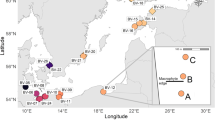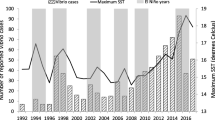Abstract
Vibrio vulnificus, an estuarine bacterium, is the causative agent of seafood-related gastroenteritis, primary septicemia, and wound infections worldwide. It occurs as part of the normal microflora of coastal marine environments and can be isolated from water, sediment, and oysters. Hindcast prediction was undertaken to determine spatial and temporal variability in the likelihood of occurrence of V. vulnificus in surface waters of the Chesapeake Bay. Hindcast predictions were achieved by forcing a multivariate habitat suitability model with simulated sea surface temperature and salinity in the Bay for the period between 1991 and 2005 and the potential hotspots of occurrence of V. vulnificus in the Chesapeake Bay were identified. The likelihood of occurrence of V. vulnificus during high and low rainfall years was analyzed. From results of the study, it is concluded that hindcast prediction yields an improved understanding of environmental conditions associated with occurrence of V. vulnificus in the Chesapeake Bay.







Similar content being viewed by others
References
Anderson CR, Sapiano MRP, Prasad MBK, Long W, Tango PJ, Brown CW, et al. 2010. Predicting potentially toxigenic Pseudo-nitzschia blooms in the Chesapeake Bay. Journal of Marine Systems. 83: 127-140.
Blake PA, Merson MH, Weaver RE, Hollis DG, and Heublein PC (1979). Disease caused by a marine Vibrio. Clinical characteristics and epidemiology. N Engl J Med 300:1-5.
Boesch DF, editor. (2008). Global warming and the free state: comprehensive assessment of climate change impacts in Maryland, Cambridge, MD: University of Maryland Center for Environmental Science.
Brauns LA, Hudson MC, and Oliver JD (1991). Use of the polymerase chain reaction in detection of culturable and nonculturable Vibrio vulnificus cells. Applied and environmental microbiology 57:2651-2655.
CDC (2008). Summary of human Vibrio cases reported to CDC. http://www.cdc.gov/nationalsurveillance/PDFs/Jackson_Vibrio_CSTE2008_FINAL.pdf. Accessed September 10, 2010.
Chesapeake Bay Foundation (2009). Bad Water 2009: The Impact on Human Health in the Chesapeake Bay Region. p 24.
Clark JS, Carpenter SR, Barber M, Collins S, Dobson A, Foley JA, et al. (2001). Ecological forecasts: an emerging imperative. Science 293:657-660.
Colwell RR (2002). A voyage of discovery: cholera, climate and complexity. Environmental microbiology 4:67-69.
Colwell RR, Kaper J, and Joseph SW (1977). Vibrio cholerae, Vibrio parahaemolyticus, and other vibrios: occurrence and distribution in Chesapeake Bay. Science 198:394-396.
Constantin de Magny G, Long W, Brown CW, Hood RR, Huq A, Murtugudde R, et al. (2010). Predicting the distribution of Vibrio spp. in the Chesapeake Bay: a Vibrio cholerae case study. EcoHealth 6:378-389.
Constantin de Magny G, Murtugudde R, Sapiano MR, Nizam A, Brown CW, Busalacchi AJ, et al. (2008). Environmental signatures associated with cholera epidemics. Proceedings of the National Academy of Sciences of the United States of America 105:17676-17681.
Decker MB, Brown CW, Hood RR, Purcell JE, Gross TF, and Matanoski JC (2007). Predicting the distribution of scyphomedusa Chrysaora quinquecirrha in Chesapeake Bay. Marine Ecology-Progress Series 329:99-113.
DePaola A, Capers GM, and Alexander D (1994). Densities of Vibrio vulnificus in the intestines of fish from the U.S. Gulf Coast. Applied and environmental microbiology 60:984-988.
DHMH (2010). Naturally occurring Vibrio bacteria rise in brackish waters during hot weather. Prevention measures urged with raw shellfish, working or swimming in the Chesapeake Bay and its tributaries. Maryland Department of Health and Mental Hygiene, Baltimore, Maryland. http://www.dhmh.state.md.us/pressreleases/pdf/2010/Vibrio_8.11.10.pdf. Accessed September 10, 2010.
Dziuban EJ, Liang JL, Craun GF, Hill V, Yu PA, Painter J, et al. (2006). Surveillance for waterborne disease and outbreaks associated with recreational water–United States, 2003-2004. MMWR Surveillance Summaries 55:1-30.
Gibson JR, and Najjar RG (2000). The response of Chesapeake bay salinity to climate-induced changes in streamflow. Limnology and Oceanography 45:1764-1772.
Gil AI, Louis VR, Rivera IN, Lipp E, Huq A, Lanata CF, et al. (2004). Occurrence and distribution of Vibrio cholerae in the coastal environment of Peru. Environ. Microbiol. 6:699-706.
Harvell CD, Kim K, Burkholder JM, Colwell RR, Epstein PR, Grimes DJ, et al. (1999). Emerging marine diseases–climate links and anthropogenic factors. Science 285:1505-1510.
Heidelberg JF, Heidelberg KB, and Colwell RR (2002a). Bacteria of the gamma-subclass Proteobacteria associated with zooplankton in Chesapeake Bay. Applied and Environmental Microbiology 68:5498-5507.
Heidelberg JF, Heidelberg KB, and Colwell RR (2002b). Seasonality of Chesapeake Bay bacterioplankton species. Applied and Environmental Microbiology 68:5488-5497.
Hoge CW, Watsky D, Peeler RN, Libonati JP, Israel E, and Morris JG, Jr. (1989). Epidemiology and spectrum of Vibrio infections in a Chesapeake Bay community. The Journal of Infectious Diseases 160:985-993.
Hsieh JL, Fries JS, and Noble RT (2007). Vibrio and phytoplankton dynamics during the summer of 2004 in a eutrophying estuary. Ecological applications : a publication of the Ecological Society of America 17:S102-S109.
Huq A, Small EB, West PA, Huq MI, Rahman R, and Colwell RR (1983). Ecological relationships between Vibrio cholerae and planktonic crustacean copepods. Applied and environmental microbiology 45:275-283.
Huq A, West PA, Small EB, Huq MI, and Colwell RR (1984). Influence of water temperature, salinity, and pH on survival and growth of toxigenic Vibrio cholerae serovar O1 associated with live copepods in a laboratory microcosms. Appl Environ Microbiol 48:420-424.
Jacobs JM, Rhodes M, Brown CW, Hood RR, Leigh A, Long W, et al. (2010). Predicting the distribution of Vibrio vulnificus in the Chesapeake Bay. Cooperative Oxford Laboratory, Oxford, MD. pp 12.
Kaspar CW, and Tamplin ML (1993). Effects of temperature and salinity on the survival of Vibrio vulnificus in seawater and shellfish. Applied and environmental microbiology 59:2425-2429.
Kaysner CA, Abeyta C, Jr., Wekell MM, DePaola A, Jr., Stott RF, and Leitch JM (1987). Virulent strains of Vibrio vulnificus isolated from estuaries of the United States West Coast. Applied and environmental microbiology 53:1349-1351.
Kelly MT (1982). Effect of temperature and salinity on Vibrio (Beneckea) vulnificus occurrence in a Gulf Coast environment. Applied and environmental microbiology 44:820-824.
Kimmel DG, Roman MR, and Zhang X (2006). Spatial and temporal variability in factors affecting mesozooplankton dynamics in Chesapeake Bay: evidence from biomass size spectra. Limnology and Oceanography 51:131-141.
Klontz KC, Lieb S, Schreiber M, Janowski HT, Baldy LM, and Gunn RA (1988). Syndromes of Vibrio vulnificus infections. Clinical and epidemiologic features in Florida cases, 1981-1987. Annals of Internal Medicine 109:318-323.
Linder K, and Oliver JD (1989). Membrane fatty acid and virulence changes in the viable but nonculturable state of Vibrio vulnificus. Applied and environmental microbiology 55:2837-2842.
Lipp EK, Huq A, and Colwell RR (2002). Effects of global climate on infectious disease: the cholera model. Clinical microbiology reviews 15:757-770.
Lipp EK, Rodriguez-Palacios C, and Rose JB (2001). Occurrence and distribution of the human pathogen Vibrio vulnificus in a subtropical Gulf of Mexico estuary. Hydrobiologia 460:165-173.
Lobitz B, Beck L, Huq A, Wood B, Fuchs G, Faruque AS, et al. (2000). Climate and infectious disease: use of remote sensing for detection of Vibrio cholerae by indirect measurement. Proceedings of the National Academy of Sciences of the United States of America 97:1438-1443.
Louis VR, Russek-Cohen E, Choopun N, Rivera IN, Gangle B, Jiang SC, et al. (2003). Predictability of Vibrio cholerae in Chesapeake Bay. Applied and environmental microbiology 69:2773-2785.
Maugeri TL, Carbone M, Fera MT, and Gugliandolo C (2006). Detection and differentiation of Vibrio vulnificus in seawater and plankton of a coastal zone of the Mediterranean Sea. Research in microbiology 157:194-200.
Mead PS, Slutsker L, Dietz V, McCaig LF, Bresee JS, Shapiro C, et al. (1999). Food-related illness and death in the United States. Emerging Infectious Disease 5:607-625.
Motes ML, DePaola A, Cook DW, Veazey JE, Hunsucker JC, Garthright WE, et al. (1998). Influence of water temperature and salinity on Vibrio vulnificus in Northern Gulf and Atlantic Coast oysters (Crassostrea virginica). Applied and environmental microbiology 64:1459-1465.
Murtugudde R (2009). Regional Earth System Prediction: a decision-making tool for sustainability. Current Opinion in Environmental Sustainability 1:37-45.
Najjar RG (1999). The water balance of the Susquehanna River Basin and its response to climate change. Journal of Hydrology 219:7-19.
Najjar RG, Pyke CR, Adams MB, Breitburg D, Hershner C, Kemp M, et al. (2010). Potential climate-change impacts on the Chesapeake Bay. Estuarine, Coastal and Shelf Science 86:1-20.
Nilsson L, Oliver JD, and Kjelleberg S (1991). Resuscitation of Vibrio vulnificus from the viable but nonculturable state. Journal of bacteriology 173:5054-5059.
O’Neill KR, Jones SH, and Grimes DJ (1992). Seasonal incidence of Vibrio vulnificus in the Great Bay estuary of New Hampshire and Maine. Applied and environmental microbiology 58:3257-3262.
Oliver JD, Nilsson L, and Kjelleberg S (1991). Formation of nonculturable Vibrio vulnificus cells and its relationship to the starvation state. Applied and environmental microbiology 57:2640-2644.
Oliver JD (2005). Wound infections caused by Vibrio vulnificus and other marine bacteria. Epidemiology and infection 133:383-391.
Parvathi A, Sanath Kumar H, Karunasagar I, and Karunasagar I (2004). Detection and enumeration of Vibrio vulnificus in oysters from two estuaries along the Southwest coast of India, using molecular methods. Applied and Environmental Microbiology 70: 6909-6913.
Paz S, Bisharat N, Paz E, Kidar O, and Cohen D (2007). Climate change and the emergence of Vibrio vulnificus disease in Israel. Environmental research 103:390-396.
Pfeffer CS, Hite MF, and Oliver JD (2003). Ecology of Vibrio vulnificus in estuarine waters of eastern North Carolina. Applied and environmental microbiology 69:3526-3531.
Randa MA, Polz MF, and Lim E (2004). Effects of temperature and salinity on Vibrio vulnificus population dynamics as assessed by quantitative PCR. Applied and Environmental Microbiology 70:5469-5476.
Roszak DB, and Colwell RR (1987). Survival strategies of bacteria in the natural environment. Microbiological reviews 51:365-379.
Shapiro RL, Altekruse S, Hutwagner L, Bishop R, Hammond R, Wilson S, et al. (1998). The role of Gulf Coast oysters harvested in warmer months in Vibrio vulnificus infections in the United States, 1988-1996. Vibrio Working Group. The Journal of Infectious Diseases 178:752-759.
Tamplin ML, Gauzens AL, Huq A, Sack DA, and Colwell RR (1990). Attachment of Vibrio cholerae serogroup O1 to zooplankton and phytoplankton of Bangladesh waters. Applied and Environmental Microbiology 56:1977-1980.
Turner JW, Good B, Cole D, and Lipp EK (2009). Plankton composition and environmental factors contribute to Vibrio seasonality. The ISME Journal 3:1082-1092.
Wright AC, Hill RT, Johnson JA, Roghman MC, Colwell RR, and Morris JG, Jr. (1996). Distribution of Vibrio vulnificus in the Chesapeake Bay. Applied and environmental microbiology 62:717-724.
Xu J, Long W, Wiggert J, Lanerolle WJ, Brown CW, and Murtugudde R (sub judice). Climate forcing and salinity variability in the Chesapeake Bay, USA. Coasts and Estuaries.
Acknowledgments
The authors gratefully acknowledge the assistance of Matt Rhodes in the development of the V. vulnificus empirical habitat suitability model (NOAA Technical Memorandum NOS NCCOS 112). This work was supported in part by National Institutes of Health-Fogarty International Center Grant No. 1RC1TW008587-01, National Science Foundation (NSF) Grant No. 0813066, National Institutes of Health Grant No. 1 R01 A139129-01, and Distinguished Scholar in Oceans and Human Health, NOAA Grant No. SO660009 for the Advanced Study Institute for Earth System Prediction. Raghu Murtugudde acknowledges the Chesapeake Bay grant from NOAA and the generous support of the Divecha Center for Climate Change, IISc-Bangalore and IITM-Pune.
Author information
Authors and Affiliations
Corresponding author
Electronic supplementary material
Below is the link to the electronic supplementary material.
Figure S1
A) Mean differences two by two of the mean probability of V. vulnificus in the three hotspot areas in 1991. B, C, and D are the mean differences and standard deviations drawn in solid and dashed line, respectively (TIFF 1107 kb)
Figure S2
Distance of the mean salinity to the optimal salinity (SALopt = 11.5 ppt, red line) at the three “hotspots”. The salinity of the Upper Bay and West estuaries during 1991 is around the optimal salinity whereas at the Mid Bay, the salinity was always higher than the optimal salinity throughout the year (TIFF 90 kb)
Figure S3
Annual anomaly of Vibrio vulnificus probability for the period between 1991 and 2005 in the upper bay, Mid-Bay, and Western estuaries (TIFF 949 kb)
Rights and permissions
About this article
Cite this article
Banakar, V., Constantin de Magny, G., Jacobs, J. et al. Temporal and Spatial Variability in the Distribution of Vibrio vulnificus in the Chesapeake Bay: A Hindcast Study. EcoHealth 8, 456–467 (2011). https://doi.org/10.1007/s10393-011-0736-4
Received:
Revised:
Accepted:
Published:
Issue Date:
DOI: https://doi.org/10.1007/s10393-011-0736-4




